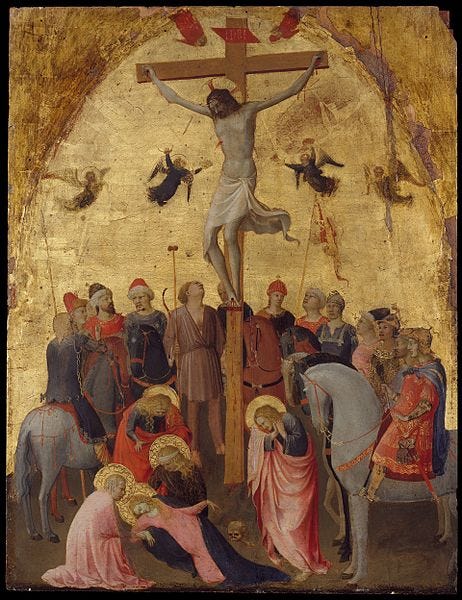"Stabat Mater: Sorrowful Mother Standing"
A Composer's Insight into the Heart of Our Sorrowful Mother
Metroplotian Museum of Art, “Crucifixion, photograph, 2017, https://en.wikipedia.org/wiki/File:The_Crucifixion_MET_DT9341.jpg.
“Now there stood by the cross of Jesus, his mother, and his mother’s sister, Mary of Cleophas, and Mary Magdalen,” (Jn 19:25, DRV). 1 When reading this passage narrated by Saint John, one might be a little surprised that further insight or information is not relayed regarding the reactions of Mary, the Mother of God: yet, surely, the scene must have indeed been heart rendering. However, the aura of mystery surrounding this moment in history has not prevented artists from attempting to reveal the sentiments of the Heart of the Mother of God.
For instance, Fra Angelico, in his depiction of The Crucifixion, features a Mother on whom the brutality of Her Son’s death has weighed heavily, thereby causing her to faint: on the other hand, William Bouguereau demonstrates the paralyzing and silently agonizing depth of Our Lady as she holds His Body immediately after He has been taken down from the Cross.2 In essence, then, both artists mentioned above seemingly attempt to illuminate and reveal the Heart of Mary, thereby allowing the viewer to come to a more complete understanding of who the Mother of the Nazarene really was.
In a similar sense, the world of music has also attempted to illuminate Our Lady’s hour of agony, as it were. As we have entered into the liturgical season of Lent, this torturous suffering of Our Lady is singularly recognized via the chant Stabat Mater which translated literally means “Mother Standing” or “Mother Stands”. While there are many versions of this piece, the one which we shall focus on specifically shall be that which is composed by Giovanni Battisita Pereglosi. (Link below).
Interestingly enough, this 18th century composer’s life was only intermittently marked by fame though, as one can tell from listening to his pieces, his genius was indeed remarkable. Pereglosi’s life was short as he did not live past 26. Nevertheless, his Stabat Mater would seem to embody an eternal characteristic as it opens up to the listener the heart of She who “ponder{ed}” the mysteries of God “in her heart,” (Lk 2:19). Though there are indeed many verses of this “hymn”, as illuminated by the article “Stabat Mater Dolorosa” by Virgo Sacrata, the first verse shall be our primary focus today: it goes as follows:
“Stabat Mater dolorosa
iuxta Crucem lacrimosa,
dum pendebat Filius.
At the Cross her station keeping,
stood the mournful Mother weeping,
close to Jesus to the last.” 3
The entrance of the hymn begins slowly and softly via the use of string instruments building in momentum until a gloriously minor crescendo. Then, the vocal aspect of the hymn commences. With the words “Stabat Mater Dolorosa” the two vocal singers create a harmonious melancholy interweaving of sound that swells in such a way as to draw the listener into this tragical moment of Our Sorrowful Mother. With these three words, one can almost feel the unwavering intensity of Mary’s gaze on her Crucified Lord.
While, the effects of this first line has brought the listener to the brink of an incomparable grief, nevertheless, one is urged to keep in perspective the entirety of the Christian reality. For, upon the utterance of the second line of the first verse, “iuxta Crucem lacrimosa”, the listener, who is brought so intimately into this overwhelming grief of the Mother of God, is allowed a glimpse of the hope that must have been equally present in her soul: namely, the realization of the truth that on “the third day he shall rise again,” (Mt 20:19). Hence, while embodying the role of Our Mother of Sorrows, she is simultaneously the Mother of God, the God of whom it is stated “Thou art my helper and my protector: and in thy word I have greatly hoped,” (Ps 118:113).
Yet, the moment of light is hereafter extinguished. For, with the words of “dum pendebat Filius”, the tone of the hymn once again pivots into a graver channel concluding with the poignant word “lacrimosa” which resolves on a note of intense dissonance, thereby allowing the listener to cathartically experience the glory of the eternal sorrow which has consecrated the life of the Virgin.
This hauntingly beautiful rendition of the Stabat Mater invites and summons the listener to enter into the heart of reality, as it were, together with “the mournful mother weeping”.4 Hence, in doing so, the way is paved for us to attain a singularly unique union with her, and, in turn, a union with Christ. For, like St. Paul, Our Blessed Mother too can claim, “with Christ I am nailed to the cross. And I live, now not I; but Christ liveth in me,” (Gal 2:20).
Check out this piece at the link below:
The Holy Bible: Douay Rheims, (Post Falls, ID: Lepanto Press).
Metropolitan Museum of Art, “Crucifixion, photograph, 2017, https://en.wikipedia.org/wiki/File:The_Crucifixion_MET_DT9341.jpg; Art Renewal Center, “William-Adolphe Bouguereau (1825-1905) - Pieta (1876),” photograph, 2007, https://en.m.wikipedia.org/wiki/File:William-Adolphe_Bouguereau_%281825-1905%29_-_Pieta_%281876%29.jpg
“Stabat Mater Dolorosa”, Virgo Sacrata, at https://www.virgosacrata.com.
“Stabat Mater Dolorosa.”




